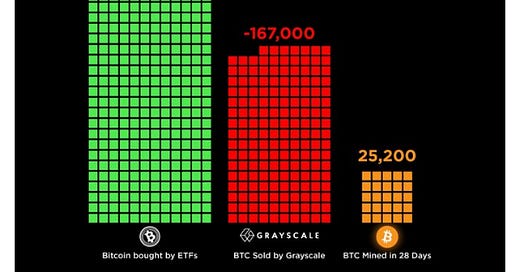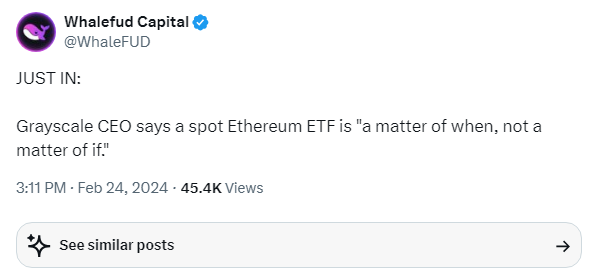Riding The Wave News Summary 220
Bitcoin mining difficulty surpasses 80 trillion ahead of halving, Grayscale’s Bitcoin ETF records lowest outflows since conversion, & more.
Welcome to Riding The Wave. If you have questions or feedback, please reply to this email. If you are new to the Newsletter, please check out what we provide on our about page and consider subscribing. Within the Newsletter, I provide News Summaries, Weekly Status Updates, & Deep Dive Articles on Specific Topics (Ex: How do I pick which coins/tokens to buy?). More details here
News
Table of Contents
Tweets
Bitcoin mining difficulty surpasses 80 trillion ahead of halving
Grayscale’s Bitcoin ETF records lowest outflows since conversion
Uniswap's UNI Jumps 60% on Proposal to Reward Token Holders in Major Governance Overhaul
Tweets
https://twitter.com/TheCryptoZombie/status/1761122243235414302
https://twitter.com/MatthewHyland_/status/1761454630561521821
https://twitter.com/WhaleFUD/status/1761483989590646997
Bitcoin mining difficulty surpasses 80 trillion ahead of halving
Bitcoin mining difficulty, which measures how difficult it is to solve the complex cryptographic puzzles used in the mining process, passed 80 trillion on Friday, Feb. 16.
The network’s hash rate, which measures the total computational power used by miners, reached 562.81 exahashes per second (EH/s), and the mining difficulty hit a record 81.73 trillion, according to BTC.com. Bitcoin mining difficulty has steadily risen since January 2023 and is expected to reach 100 trillion in the next few months.
In Bitcoin’s proof-of-work consensus mechanism, a higher difficulty means miners require more computational power and energy to find the correct hash. In the last year, Bitcoin’s difficulty level has more than doubled.
Bitcoin’s mining rewards will be cut in half in April in what’s known as the Bitcoin Halving. To fight inflation, Bitcoin’s programmers baked the reduction into the token’s structure roughly every four years. The last time Bitcoin’s mining reward halved was in May 2020.
Bitcoin’s rewards will decrease from 6.25 BTC to 3.125 BTC during the upcoming halving. This change might result in a lower hash rate, as less efficient miners could find it challenging to cover their costs and take their mining rigs offline. A reduced hash rate is likely to cause a decrease in Bitcoin mining difficulty as the network aims to keep a steady block production every 10 minutes.
Grayscale’s Bitcoin ETF records lowest outflows since conversion
Grayscale’s Bitcoin Trust (GBTC) has seen outflows reach their lowest point over the past few days, signaling a slowdown in withdrawal volumes.
According to data from BitMEX Research, GBTC had withdrawals of $44.2 million on Feb. 23, the lowest daily volume since its conversion on Jan. 11 from an over-the-counter product to an exchange-traded fund (ETF).
By the end of January, GBTC reported withdrawals totaling $5.64 billion, with a significant $640 million exiting on Jan. 22 alone. February has seen a decline in outflows, amounting to $1.8 billion so far. Since its inception, GBTC has witnessed a total withdrawal of $7.4 billion.
In contrast, BlackRock's IBIT has amassed over $6.6 billion in investment since launching, followed by Fidelity’s FBTC with over $4.7 billion in capital. The third position is held by ARK 21Shares, with inflows of $1.4 billion over the same period.
Grayscale’s Bitcoin fund may have another challenge ahead. The bankrupt crypto firm Genesis Global Holdco was recently granted court permission to sell $1.3 billion in GBTC's shares to reimburse investors.
Uniswap's UNI Jumps 60% on Proposal to Reward Token Holders in Major Governance Overhaul
Keep reading with a 7-day free trial
Subscribe to Riding The Wave to keep reading this post and get 7 days of free access to the full post archives.





